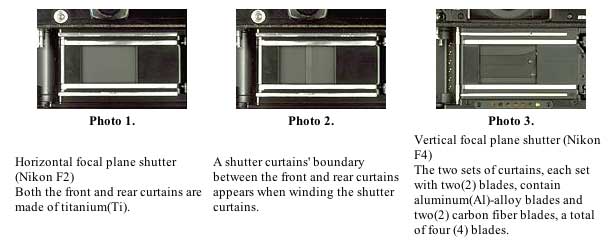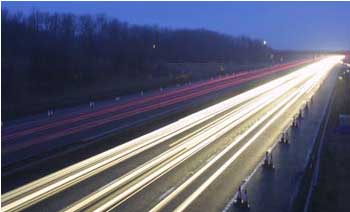Shutter...Continue
2.3 Shutter speed and picture blur
Blurring is a problem when taking photos at slow shutter speeds.
If the subject moves, it will appear blurred.
If the camera is jostled, the entire image will be blurry.
The problem only increases when shooting with a telephoto lens or shooting close-ups.
Lenses with high magnification (shooting with a telephoto lens or taking close-up pictures) causes more picture blur.
The best way to minimize blurring is to use a monopod or tripod.
Blurring due to hand-held camera shake can be minimized by shooting the picture at 1 / focal length (in mm). For example, with a 200 mm
telephoto lens, a shutter speed of 1 / 200 sec or faster is best. As for me, I choose a shutter speed a bit faster than this equation.
In any case, you can take less blurring, instantaneous picture at fast shutter speed.

1.1. Focal-plane shutter mechanism
The focal plane is the focusing surface, which means that the shutter is directly in front of the film. Because
it's in this position, there is no real need to screen light when changing lenses.
A conventional focal plane shutter consists of two blades or two sets of blades that block light.
Exposure time is adjusted by making these blades pass by the film at different times.
The first blade is called the front curtain; the second is called the rear curtain.
The object you see when you open the back cover of an SLR camera is the shutter curtain. Do not touch it !
One type of shutter curtain, called a horizontal-travel focal plane shutter, moves sideways.
The conventional horizontal type, called a drum-type shutter, is usually made of silk cloth or metal
(stainless steel, titanium (Ti), etc.).
A shutter curtain that travels vertically is called a vertical-travel focal plane shutter.
On occasion, you might find a drum-type shutter that travels vertically; but most modern SLR cameras have two(2) curtains.
These are usually referred to as square shutters
This square shutter is composed of a front and rear curtain, each made of long, thin blades in a layered configuration.
Think of an elevator door, and you have an idea how they operate.

Slow shutter speed with daylight exposure
There are a few techniques you can try here. The first is following the subject as it moves - a technique known as panning. You select a
slow shutter speed and follow the subject as it moves, pressing the shutter button as you pan. If you get it right the subject will appear
sharp as it hasnít moved position in the viewfinder, but the background will be blurred making the subject look as though itís hurtling along.
Try this on cyclists, cars, airplanes, joggers, animals and sporting activities.

Another method of creating movement is to keep the camera at a fixed point and press the shutter button using a slow shutter speed. This time
the subject will be blurred as it passes across the viewfinder and the background will be sharp. This takes a lot of skill to get the detail
right as the subject can often look too blurred resulting in a photograph with no impact.

The third technique is same as our previous example, but used to remove the subject. Itís employed by architectural photographers who want to
photograph a building without people getting in the way. If the shutter speed is slow theyíll record as a blurred and distracting object,
but if itís extremely long the blurred person walking across the path of the view will be so blurred it wonít even be recognisable and wonít
affect the picture.
A long shutter speed can be set at night to record car headlights as trails. Choose a position on a suitable bridge over a busy road and
tripod mount the camera. Then fire the shutter with a speed of between one and 15 seconds depending on the length of streak you require.

Fast shutter speed in daylight
The alternative of selecting a slow shutter speed is to go for a fast shutter speed to do the exact opposite Ė
to stop your subject in its tracks. In this case you need to use a shutter speed faster than the speed of
the moving subject, which varies depending on the direction too. If the subject is moving across the path
at close range it will appear to be moving faster than a distant subject and a faster speed will be needed.
And if itís coming towards you, duck!

Using a subject freezing shutter speed is perfect if you want to stop a goal-scoring footballer in is tracks,
freeze an athlete in mid air or an insect or bird in mid flight. Itís less effective for cars or vehicles
as it makes them look static.






